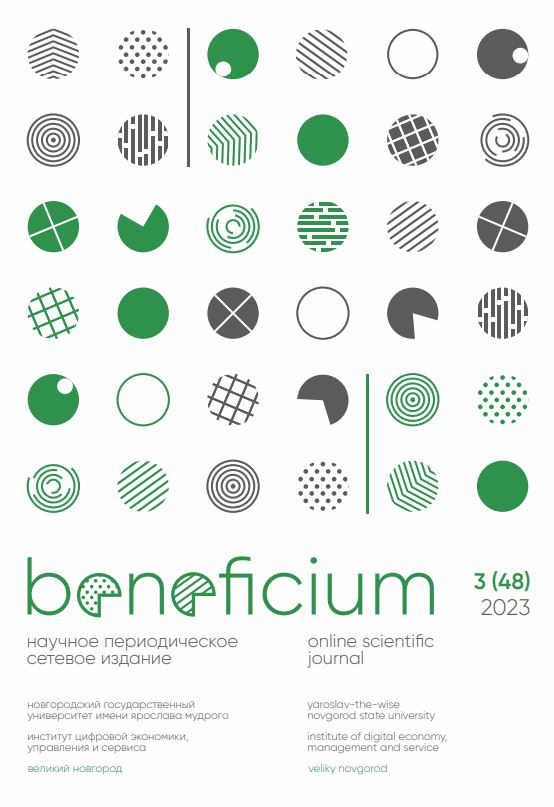RISK, RETURN AND CEO’S CHARACTERISTICS AS FACTORS OF COMPANY’S EFFICIENCY
Abstract
The aim of this paper is to combine and analyse the relationship between the company’s financial characteristics: risk, return, and the leaders’ characteristics for various stages of the organization’s life cycle. The results of the empirical analysis of this paper reveal the dependencies between both the physiological and personal characteristics of leaders. Such indicators as education, previous experience as a Chief Executive Officer (CEO), CEO remuneration, and the number of years in the current position were evaluated for this analysis. The sample is represented by 409 companies included in the S&P 500 index. The profitability of the companies is assessed using an integral indicator, whereas the risk is assessed using the Leverage Beta coefficient and the Altman Z-account. The stages of the company’s life cycle are distinguished through the ratio of cash from operating, financial, and investment activities. This paper also examines the position of companies as an analogue of the portfolio and is noted on the Capital Market Line (CML). To assess the relationship, decision trees were built taking into account risk and return for different stages of the life cycle of companies: “growth”, “maturity” and “decline”. As a result, it has been concluded that different characteristics of leaders are significant at various stages of the organization’s life cycle. So, for the “growth” stage, the remuneration has a positive effect on the risk indicator, but after a certain level of increase, it has a completely inverse relationship. The indicator for a leader’s education is non-linear, and the education received in the financial sphere has a negative relationship with the company’s risk indicator for the “growth” stage. The indicator for the CEO’’s previous work is more significant for risk assessment than the company’s return.
Keywords: business indicators of a company, Life Cycle Organization, Capital Market Line, Capital Asset Pricing Model, Chief Executive Officer, characteristics of leaders
References
Adizes I. Managing corporate lifecycles. Santa Barbara, Calif.: Adizes Institute Pub, 2004. 486 p.
Shirokova G.V., Merkurieva I.S., Serova O.Y. Osobennosti formirovaniya zhiznennyh ciklov rossijskih kompanij (empiricheskij analiz) [Specifics of life cycle formation in the Russian companies (the results of empirical analysis)] // Russian Management Journal. 2006. Vol. 4(3). Pp. 3-26. (In Russ.).
Bruwer B.W., Hamman W.D. Cash flow patterns in listed South African industrial companies // Meditari Accountancy Research. 2005. Vol. 13(1). Pp. 1-17. DOI: 1108/10222529200500001
Ovanesova Yu.S., Zhitikhin S.S. The relationship between CEO personal traits and technology companies’ performance at different stages of the life cycle // Russian Management Journal. 2021. Vol. 18(4). Pp. 575–604. (In Russ.). DOI: 21638/spbu18.2020.
Bloomberg (2023). URL: https://www.bloomberg.com/europe (accessed on 06.03.2022).
com (2023). URL: https://www.salary.com/ (accessed on 01.03.2022).
Yahoo finance (2023). URL: https://www.finance.yahoo.com (accessed on 10.03.2022).
Google Finance (2023). (In Russ.). URL: https://www.google.com/finance (accessed on03.2022).
Morningstar (2023). URL: https://www.morningstar.com (accessed on 11.03.2022).
Kommersant (2023). (In Russ.). URL: https://www.kommersant.ru (accessed on 06.04.2022).
Review ML Space (2023). Cloud.ru. (In Russ.). URL: https://docs.sbercloud.ru/aicloud/mlspace/concepts/automl.html (accessed on 15.04.2022).
Amran N.A., Ishak R., Aripin N. Do Characteristics of CEO and Chairman Influence Government - Linked Companies performance? // Procedia - Social and Behavioral Sciences. Vol. 109. Pp 799-803. DOI: 10.1016/j.sbspro.2013.12.546
Chaganti R., Zimmerman M., Kumaraswamy A., Maggitti P.G., Arkles J.B. TMT Characteristics, Time-to-IPO and Firm Performance // Journal of Management & Public Policy. 2016. Vol. 7(2). Pp. 37-56.
Elsaid E., Wang X., Davidson W. Does experience matter? CEO successions by former CEOs // Managerial Finance. 2011. Vol. 37(10). Pp 915-939.DOI: 1108/03074351111161583
Cooper M.J., Gulen H., Rau P.R. Performance for Pay? The Relation Between CEO Incentive Compensation and Future Stock Price Performance // Corporate Governance: Compensation of Executive & Directors eJournal. 2016. Pp. 1-52. DOI: 2139/ssrn.1572085
Beber A., Fabbri D. Who Times the Foreign Exchange Market? Corporate Speculation and CEO Characteristics // Journal of Corporate Finance. Vol. 18(5). Pp.1065-1087. DOI: 10.1016/j.jcorpfin.2012.07.004Nguyen M.H., Ha T.T.M., Vuong P.M. The effect of CEO characteristics on financial leverage: findings from listed companies in Vietnam // Cogent Business & Management. Vol. 8(1). DOI: 10.1080/23311975.2021.2002129
Zhou W., Wang Y. An Empirical Study for Corporate Risk Index: CEO Characteristics Affecting Corporate Risk-Taking // Journal of Applied Sciences. 2014. Vol. 14(24). Pp. 3520-3525. DOI: 3923/jas.2014.3520.3525
Madyan M., Harymawan I., Minanurohman A., Setiawan W.R. The Impact of Top Management Education from Reputable Universities on Corporate Capital Structure: Evidence from Indonesia // Global Business Review. 2023. DOI: 1177/09721509231182525
About the Authors
Yulia S. Ovanesova – Cand. Sci. (Economics); Associate Professor, Higher School of Economics University, Moscow, Russia. E-mail: Julia.ovanesova@yandex.ru. SPIN РИНЦ 6345-8740 . ORCID 0000-0002-0410-550X. ResearcherID L-3157-2015. Scopus Author ID 2002362988
Artem V. Ponomarev – Master of Economics, Higher School of Economics University, Moscow, Russia. E-mail: Avponomarev_2@edu.hse.ru
For citation: Ovanesova Yu.S., Ponomarev A.V. Risk, Return and CEO’s Characteristics as Factors of Company’s Efficiency // Beneficium. 2023. Vol. 3(48). Pp. 89-103. (In Russ.). DOI: 10.34680/BENEFICIUM.2023.3(48).89-103









